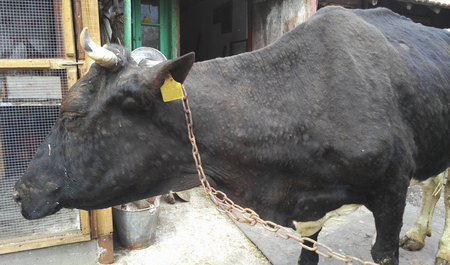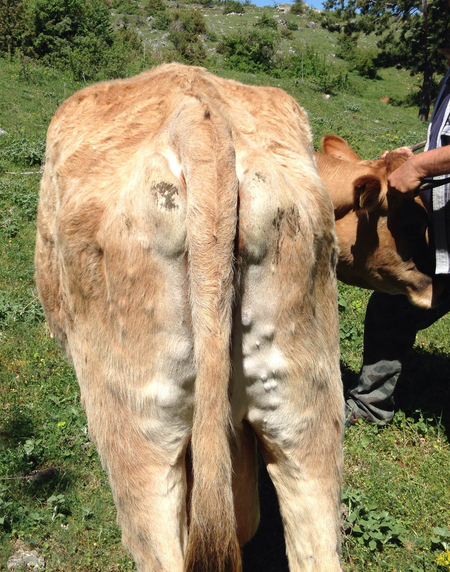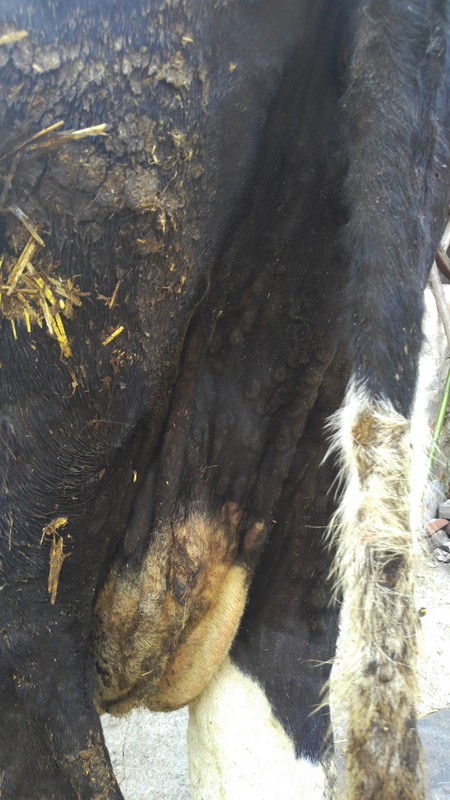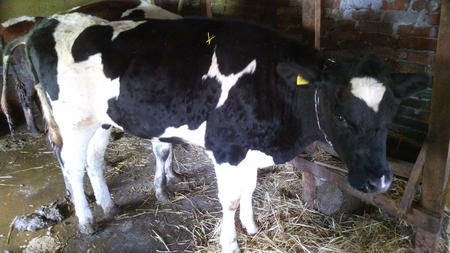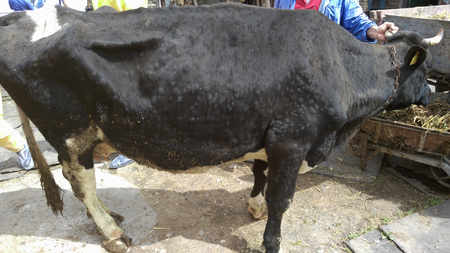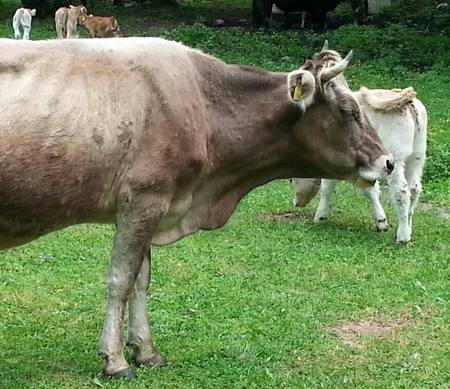Lumpy Skin Disease
Lumpy Skin Disease
Occurrence
For a long time, lumpy skin disease was endemic exclusively in East, South and West Africa. The first detection of lumpy skin disease in the EU was in August 2015. The disease was successfully controlled in 2018. There were no outbreaks in the EU in the following years.
Italy reported its first outbreak of lumpy skin disease on 23 June 2020, which occurred on a cattle farm in Sardinia. Another outbreak was reported in northern Italy in Lombardy on 25 June 2025. The sudden appearance of LSD in northern Italy is due to animal traffic from the first outbreak farm in Sardinia.
France reported its first outbreak of lumpy skin disease on 30/06/2025 in Auvergne-Rhone-Alpes, Savoie region, Chambery area. The affected cattle farm is located close to the border with Switzerland.
Further outbreaks are currently being reported from both countries.
Current information on the epidemiological situation can be found at Lumpy Skin Disease (LSD) - KVG
Infection route
The most important role for the spread of lumpy skin disease is indirect pathogen spread by insects and mites (vectors), e.g. horseflies, flies, midges, mosquitoes, mites. Transmission is also possible through direct contact, infected semen, untreated animal hides and skins and their products (e.g. hunting trophies), raw meat products, raw milk products and through animal feed obtained from them, including colostrum.
Prevention
In addition to the culling of infected and susceptible animals in the herd ("total stamping out") and movement restrictions on susceptible animals and animal products, widespread vaccination is considered the most effective measure to combat the disease. The vaccine is not authorised in Austria; its use requires authorisation from the competent authorities.
Specialist information
The lumpy skin disease virus (LSDV) belongs to the genus Capripoxvirus alongside the sheep pox virus (SPPV) and the goat pox virus (GTPV). Host animals in Europe are mainly bovine ruminants kept as livestock (cattle, buffalo, bison, zebu). Despite being kept together with small ruminants and New World camelids, no clinical cases of LSD have been reported in Europe in sheep, goats, alpacas or llamas. Wild ruminants were also not affected. Tests on roe deer in infected areas in Bulgaria have so far been negative.
The first detection of lumpy skin disease in the EU was in August 2015 in Greece, in the Evros Delta near the Turkish-Greek border. The disease spread from Greece to south-east Europe. In 2016, there were numerous outbreaks in Bulgaria, North Macedonia, Greece, Albania, Montenegro, Kosovo and southern Serbia. In Europe, it was possible to combat the disease with the help of several measures, particularly comprehensive vaccination programmes. In the Balkan region, the number of outbreaks of lumpy skin disease fell from 7,483 in 2016 to 385 in 2017. The European figures confirm that vaccinating cattle with a homologous vaccine - recommended by the EFSA in 2016 - is the most effective way to contain the disease: as of 2018, no cases of LSD have been reported in Europe. However, local outbreaks continue to occur in Israel, Syria and Turkey. Georgia, Russia, Kazakhstan, Armenia and Azerbaijan have also recorded cases of LSD. Heterologous vaccines against LSD were often used in these countries. In 2019, the disease was imported to China, India, Bangladesh, and in 2020 to Pakistan, Bhutan, Hong Kong, Myanmar, Nepal, Sri Lanka, Taiwan and Vietnam. In 2023, Indonesia was already affected by LSD. The cause of the rapid spread is thought to be the transmission of the pathogens by mites and insects, through contact between animals, but also through animal movement and wind dispersal of the vectors. The disease is currently widespread in Asia. America, Australia and New Zealand are not yet affected. For the current worldwide spread, see WOAH World Animal Health Information Database (WAHID) Interface.
Transmission by vectors, blood-sucking insects and mites, is cited as the most important cause of the spread of the disease in Europe, along with the movement of subclinically infected animals. As vector research is costly and direct control of the animal disease was the first priority in the affected countries, only a few scientifically sound data on vectors in Europe have been collected to date. The transmission of the disease by Culicidae(Aedes aegyptii) and Muscidae(Stomoxys calcitrans, Haematobia irritans) as well as by mites(Rhipicephalus appendiculatus, R. decoloratus and Amblyomma hebraeum) is considered scientifically proven. Other possible vectors are blood-sucking mites(Ixodidae), Culicidae (mosquitoes), Culicoides (e.g. the midge Culicoides punctatus) and Muscidae (e.g. the calf mosquito Stomoxys calcitrans). The pathogens can also be spread through indirect contact, e.g. through infected semen, through stable equipment that has come into contact with pathogens or through transport vehicles (e.g. through infected insects in the loading area, through tyre contact with crusts that have fallen off infected animals) and iatrogenically. Direct contact between infected and healthy adult animals plays a minor role in the transmission of the disease. Calves can become infected by sucking on the udder of infected dams. Infected dams can give birth to infected calves with skin lesions. Capripox viruses have been detected in untreated animal hides and skins and their products (e.g. hunting trophies), in raw meat products and raw milk products as well as in animal feed obtained from them.
Most outbreaks of LSD in Europe occurred between May and August - the time of year with the highest vector density. Vaccinations should therefore be carried out before vectors appear. Since no season in Europe is free of vectors and many vectors are also present in stables, LSD outbreaks have also occurred in some cases outside the period mentioned. Areas with a high density of cattle, common pastures and water points increased the risk of spreading the disease. Standing small bodies of water in the neighbourhood of farms should therefore be avoided as they are breeding grounds for insects. Geographical topography only played a role insofar as the accumulation of arthropods is greater along bodies of water. Infections with LSD even occurred in areas with altitudes of up to 1500 metres (Montenegro, Turkey). High vector density, high population density of livestock, outbreak foci around agricultural farm clusters as well as a favourable geographical location of the outbreak foci were advantageous for the spread of LSD. Mortality and morbidity in infected European cattle herds varied regionally between 0-100 % in the epidemic years 2016 and 2017; on average, morbidity in Albania, for example, was 0.8-7.2 % and mortality 0.3-2.9 %.
Symptomatology
The course of the disease in cattle is acute to subacute, sometimes chronic. Typical symptoms are
- a papulo-vesicular exanthema, which can occur in the form of 0.5-5cm large skin nodules, preferably on the head, neck, tail area, perineum, external genital organs (udder mastitis!) and extremities. Only 40-50 % of cattle develop generalised skin swellings.
- biphasic fever attacks of up to 41 °C
- greatly enlarged lymph nodes
- necrotic lesions in the organs of the respiratory tract (trachea, lungs), skeletal muscles, subcutaneous tissue, stomach and uterus
- Increased salivation and lacrimation
- fatigue, loss of appetite, weight loss
- Conjunctivitis (can lead to blindness)
- Lack of tolerance reflex in female animals
- Infectious abortions
Differential diagnosis includes infection with BHV-2 (syn. pseudo lumpy skin disease), parapox, demodicosis and dermatophilosis, an infection with the bacterium Dermatophilus congolensis.
If there is the slightest suspicion, samples (skin necrosis, tear fluid, nasal secretions, saliva, serum and EDTA blood) should be taken by the official veterinarian.
The following symptom images from Bulgaria (2016) were kindly provided by our Bulgarian colleagues. The images show the swelling of the skin typical of lumpy skin disease.
Control / Prevention
Due to the diversity of the vectors and the resulting control methods, combating LSD vectors posed a major, almost unmanageable challenge for the affected countries in the EU. As a result, very little scientifically sound data is available on vectors in Europe. In addition to the culling of infected and susceptible animals in the herd ("total stamping out") and movement restrictions on susceptible animals and animal products, comprehensive vaccination (95% coverage) with a homologous, attenuated LSDV strain (Neethling) is considered the most effective measure to combat the disease. The vaccine is not authorised in Austria and its use requires authorisation from the competent authorities. 28 days after vaccination, most cattle were protected by antibodies. A small percentage of cattle developed symptoms such as fever, loss of milk, oedema and skin nodules near the injection site 2 weeks after vaccination. The symptoms disappeared after a short time. Vaccinations in Asia with a heterologous vaccine strain, a sheep or goat pox virus strain, are less effective. In these countries (e.g. Turkey), the disease has still not been completely eliminated. Recombinations between field and vaccine strains (Neethling, KSGP) occurred in both Asia and Africa; field infections had incorporated parts of the live vaccine strain, the Neethling strain or KGSP strain. Nevertheless, according to scientific expertise, the vaccine based on the Neethling strain, manufactured by a company that produces according to strict GMP rules, is still considered one of the safest vaccines for combating LSD.
Compliance with biosecurity, targeted, timely information campaigns, support for the farming population, the culling of all animals on an infected farm and the disposal of animal carcasses in a manner relevant to the epidemic were major challenges in the affected regions during the outbreak. The use of repellents in stables, the disinfection of agricultural vehicles used in the epidemic area, the affected stables and agricultural tools also made a significant contribution to controlling the vectors.
Diagnostics
Skin lesions, blood and excretions (tear fluid, saliva) are used for the diagnostic tests. The samples are analysed using internationally recognised molecular biological (PCR and sequencing), virological (isolation using cell culture) and serological methods (SNT, ELISA). The National Reference Laboratory for Capripox can differentiate between field strain (incl. recombined field strain) and vaccine strain using PCR. The diagnostic methods are also used in exclusion diagnostics. Exclusion diagnostics not only enable the early detection of an epidemic; they also serve to maintain the competence of laboratory diagnostic tests and the emergency plan. In 2017 and 2018, 15 cattle with mostly conspicuous skin symptoms were examined as part of the exclusion diagnostics. All cases were LSD-negative.
Sample type for sampling:
Live animals:
- Skin lesions and/or skin crusts
- Salivary fluid (native in tubes or swabs possible - no bacteriological swab transport media)
- Nasal and ocular fluid (with swab - no bacteriological swab transport media)
- Blood (EDTA/heparin) and serum
Animal carcass (dead):
- Skin lesions and/or skin crusts
- Lymph nodes
- Spleen
- Lungs and altered regions of the respiratory tract
- Nasal fluid (with swab - no bacteriological swabs)
Contact
Institut für veterinärmedizinische Untersuchungen Mödling
- vetmed.moedling@ages.at
- +43 50 555 38112
-
Robert Koch-Gasse 17
2340 Mödling
Last updated: 04.12.2025
automatically translated
